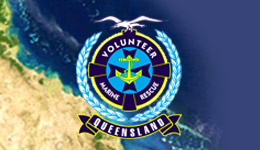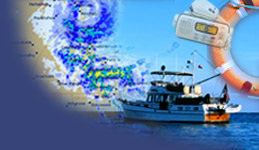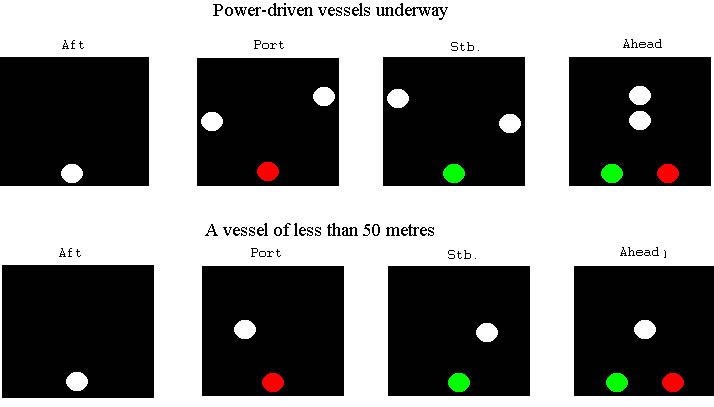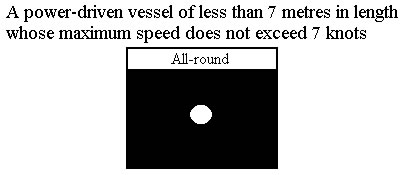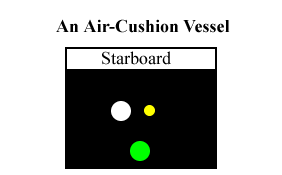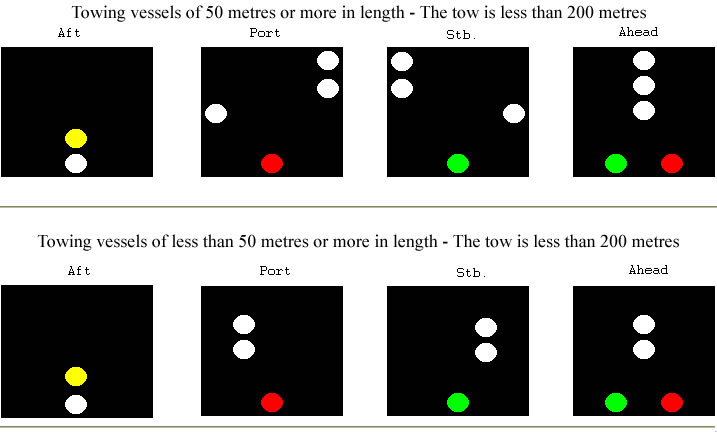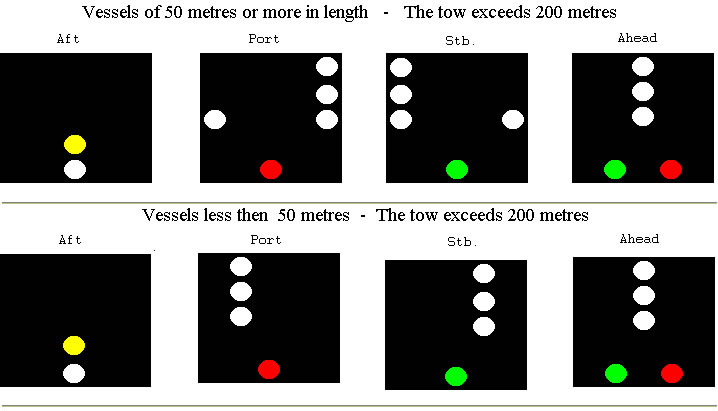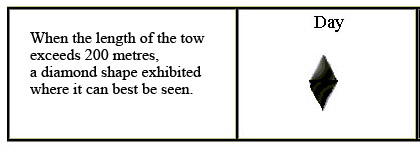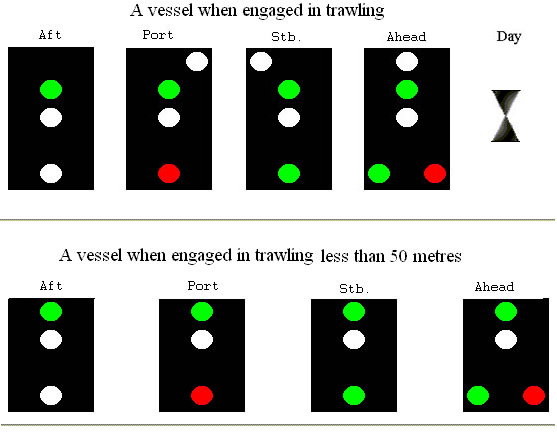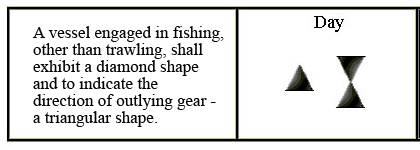Collision Regulations | Restricted Visibility |
Navigation lights are required to be shown on ships operating between sunset and sunrise, and in restricted visibility. Navigation lights indicate the size of the ship, the angle where you see them, the direction the ship is travelling, or if the ship is anchored. When operating a vessel in conditions of restricted visibility it is important to use common sense and be ready to take immediate action.
Navigation Light PlacementMasthead Light means a white light placed over the fore and aft centreline of the vessel showing an unbroken light over an arc of the horizon of 225 degrees and so fixed as to show the light from right ahead to 22.5 degrees abaft the beam on either side of the vessel. Sidelights means a green light on the starboard side and a red light on the port side each showing an unbroken light over an arc of the horizon of 112.5 degrees and so fixed as to show the light from right ahead to 22.5 degrees abaft the beam on its respective side. In a vessel of less than 20 metres in length the sidelights may be combined in one lantern carried on the fore and aft centerline of the vessel. Sternlight means a white light placed as nearly as practicable at the stern showing an unbroken light over an arc of the horizon of 135 degrees and so fixed as to show the light 67.5 degrees from right aft on each side of the vessel. Towing Light means a yellow light having the same characteristics as the sternlight. All-round Light means a light showing an unbroken light over an arc of the horizon of 360 degrees. Flashing Light means a light flashing at regular intervals at a frequency of 120 flashes or more per minute.
|
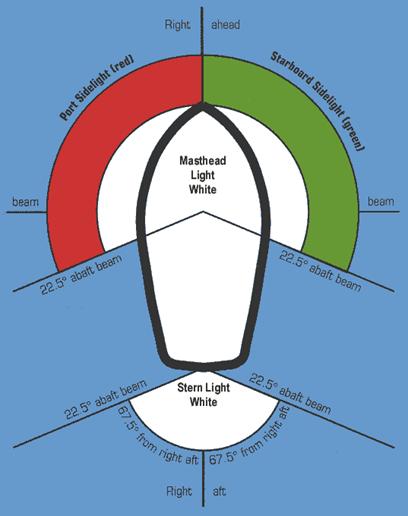 |
Navigation Light Requirements and Rules
|
||||||||||||||||||||||||||||||||||||||||||||||
Visibility of Lights (Rule 22)The lights prescribed in these Rules shall have an intensity so as to be visible at the following minimum ranges:
|
||||||||||||||||||||||||||||||||||||||||||||||
Power-Driven Vessels Underway (Rule 23)
|
||||||||||||||||||||||||||||||||||||||||||||||
Towing and Pushing (Rule 24)
|
| (a) | A power-driven vessel when towing shall exhibit: | |
| (i) instead of the light prescribed in Rule 23(a)(i) or (a)(ii), two masthead lights in a vertical line. When the length of the tow, measuring from the stern of the towing vessel to the after end of the tow exceeds 200 metres, three such lights in a vertical line; (ii) sidelights; (iii) a sternlight; (iv) a towing light in a vertical line above the sternlight; (v) when the length of the tow exceeds 200 metres, a diamond shape where it can best be seen. |
||
| (b) | When a pushing vessel and a vessel being pushed ahead are rigidly connected in a composite unit they shall be regarded as a power-driven vessel and exhibit the lights prescribed in Rule 23. | |
| (c) | A power-driven vessel when pushing ahead or towing alongside, except in the case of a composite unit, shall exhibit: | |
| (i) instead of the light prescribed in Rule 23(a)(i) or (a)(ii), two masthead lights in a vertical line; (ii) sidelights; (iii) a sternlight. |
||
| (d) | A power-driven vessel to which paragraph (a) or (c) of this Rule applies shall also comply with Rule 23(a)(ii). | |
| (e) | A vessel or object being towed, other than those mentioned in paragraph (g) of this Rule, shall exhibit: | |
| (i) sidelights; (ii) a sternlight; (iii) when the length of the tow exceeds 200 metres, a diamond shape where it can best be seen. |
||
| (f) | Provided that any number of vessels being towed alongside or pushed in a group shall be lighted as one vessel, | |
| (i) a vessel being pushed ahead, not being part of a composite unit, shall exhibit at the forward end, sidelights; (ii) a vessel being towed alongside shall exhibit a sternlight and at the forward end, sidelights. |
||
| (g) | An inconspicuous, partly submerged vessel or object, or combination of such vessels or objects being towed, shall exhibit: | |
| (i) if it is less than 25 metres in breadth, one all-round white light at or near the forward end and one at or near the after end except that dracones need not exhibit a light at or near the forward end; (ii) if it is 25 metres or more in breadth, two additional all-round white lights at or near the extremities of its breadth; (iii) if it exceeds 100 metres in length, additional all-round white lights between the lights prescribed in subparagraphs (i) and (ii) so that the distance between the lights shall not exceed 100 metres; (iv) a diamond shape at or near the aftermost extremity of the last vessel or object being towed and if the length of the two exceeds 200 metres an additional diamond shape where it can best be seen and located as far forward as is practicable. |
||
| (h) | Where from any sufficient cause it is impracticable for a vessel or object being towed to exhibit the lights or shapes prescribed in paragraph (e) or (g) of this Rule, all possible measures shall be taken to light the vessel or object towed or at least to indicate the presence of such vessel or object. | |
| (i) | Where from any sufficient cause it is impracticable for a vessel not normally engaged in towing operations to display the lights prescribed in paragraph (a) or (c) of this Rule, such vessel shall not be required to exhibit those lights when engaged in towing another vessel in distress or otherwise in need of assistance. All possible measures shall be taken to indicate the nature of the relationship between the towing vessel and the vessel being towed as authorized by Rule 36, in particular by illuminating the towline. |
|
| Refer to pages 75-114, Chapter 7: Collision Regulations, Small Ships Training and Operational Manual, 4th Ed (2005) Maritime Safety Queensland See also John Mellor, A Small Boat Guide to Rules of the Road: The Collision Regulations Simplified, Wiley Press, 2006 |
Sailing Vessels Underway and Vessels Under Oars (Rule 25)
| (a) | A sailing vessel underway shall exhibit: | |
| (i) sidelights; (ii) a sternlight. |
||
| (b) | In a sailing vessel of less than 20 metres in length the lights prescribed in paragraph (a) of this Rule may be combined in one lantern carried at or near the top of the mast where it can best be seen. | |
| (c) | A sailing vessel underway may, in addition to the lights prescribed in paragraph (a) of this Rule, exhibit at or near the top of the mast, where they can best be seen, two all-round lights in a vertical line, the upper being red and the lower green, but these lights shall not be exhibited in conjunction with the combined lantern permitted by paragraph (b) of this Rule. | |
| (d) | (i) A sailing vessel of less than 7 metres in length shall, if practicable, exhibit the lights prescribed in paragraph (a) or (b) of this Rule, but if she does not, she shall have ready at hand an electric torch or lighted lantern showing a white light which shall be exhibited in sufficient time to prevent collision. (ii) A vessel under oars may exhibit the lights prescribed in this Rule for sailing vessels, but if she does not, she shall have ready at hand an electric torch or lighted lantern showing a white light which shall be exhibited in sufficient time to prevent collision. |
|
| (e) | A vessel proceeding under sail when also being propelled by machinery shall exhibit forward where it can best be seen a conical shape, apex downwards. |
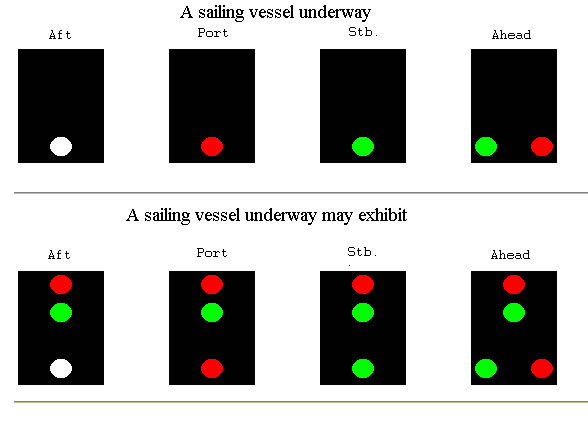 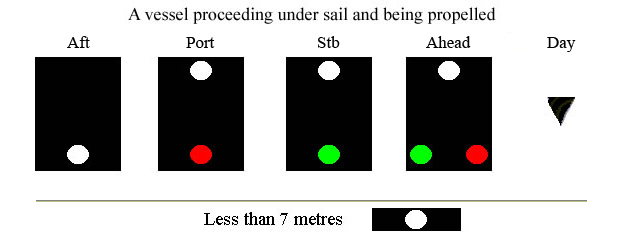 |
| Refer to pages 75-114, Chapter 7: Collision Regulations, Small Ships Training and Operational Manual, 4th Ed (2005) Maritime Safety Queensland See also John Mellor, A Small Boat Guide to Rules of the Road: The Collision Regulations Simplified, Wiley Press, 2006 |
Fishing Vessels (Rule 26)
| (a) | A vessel engaged in fishing, whether underway or at anchor, shall exhibit only the lights and shapes prescribed in this Rule. | |
| (b) | A vessel when engaged in trawling, by which is meant the dragging through the water of a dredge net or other apparatus used as a fishing appliance, shall exhibit: | |
| (i) two all-round lights in a vertical line, the upper being green and the lower white, or a shape consisting of two cones with their apexes together in a vertical line one above the other; (ii) a masthead light abaft of and higher than the all-round green light; a vessel of less than 50 metres in length shall not be obliged to exhibit such a light but may do so; (iii) when making way through the water, in addition to the lights prescribed in this paragraph, sidelights and a sternlight. |
||
| (c) | A vessel engaged in fishing, other than trawling, shall exhibit: | |
| (i) two all-round lights in a vertical line, the upper being red and the lower white, or a shape consisting of two cones with apexes together in a vertical line one above the other; (ii) when there is outlying gear extending more than 150 metres horizontally from the vessel, an all-round white light or a cone apex upwards in the direction of the gear; (iii) when making way through the water, in addition to the lights prescribed in this paragraph, sidelights and a sternlight. |
||
| (d) | The additional signals described in Annex II to these Regulations apply to a vessel engaged in fishing in close proximity to other vessels engaged in fishing. | |
| (e) | A vessel when not engaged in fishing shall not exhibit the lights or shapes prescribed in this rule, but only those prescribed for a vessel of her length. |
|
| Refer to pages 75-114, Chapter 7: Collision Regulations, Small Ships Training and Operational Manual, 4th Ed (2005) Maritime Safety Queensland See also John Mellor, A Small Boat Guide to Rules of the Road: The Collision Regulations Simplified, Wiley Press, 2006 |
Vessels Not Under Command or Restricted in their Ability to Manoeuvre (Rule 27)
| (a) | A vessel not under command shall exhibit: | |
| (i) two all-round red lights in a vertical line where they can best be seen; (ii) two balls or similar shapes in a vertical line where they can best be seen; (iii) when making way through the water, in addition to the lights prescribed in this paragraph, sidelights and a sternlight. |
||
| (b) | A vessel restricted in her ability to manoeuvre, except a vessel engaged in mine clearance operations, shall exhibit: | |
| (i) three all-round lights in a vertical line where they can best be seen. The highest and lowest of these lights shall be red and the middle light shall be white; (ii) three shapes in a vertical line where they can best be seen. The highest and lowest of these shapes shall be balls and the middle one a diamond; (iii) when making way through the water, a masthead light or lights, sidelights and a sternlight, in addition to the lights prescribed in subparagraph (i); (iv) when at anchor, in addition to the lights or shapes prescribed in subparagraphs (i) and (ii), the light, lights or shape prescribed in Rule 30. |
||
| (c) | A power-driven vessel engaged in a towing operation such as severely restricts the towing vessel and her tow in their ability to deviate from their course shall, in addition to the lights or shape prescribed in Rule 24(a), exhibit the lights or shapes prescribed in subparagraphs (b)(i) and (ii) of this Rule. | |
| (d) | A vessel engaged in dredging or underwater operations, when restricted in her ability to manoeuvre, shall exhibit the lights and shapes prescribed in subparagraphs (b)(i), (ii) and (iii) of this Rule and shall in addition, when an obstruction exists, exhibit: | |
| (i) two all-round red lights or two balls in a vertical line to indicate the side on which the obstruction exists; (ii) two all-round green lights or two diamonds in a vertical line to indicate the side on which another vessel may pass; (iii) when at anchor, the lights or shapes prescribed in this paragraph instead of the lights or shape prescribed in Rule 30. |
||
| (e) | Whenever the size of a vessel engaged in diving operations makes it impracticable to exhibit all lights and shapes prescribed in paragraph (d) of this Rule, the following shall be exhibited: | |
| (i) three all-round lights in a vertical line where they can best be seen. The highest and lowest of these lights shall be red and the middle light shall be white; (ii) a rigid replica of the International Code flag "A" not less than 1 metre in height. Measures shall be taken to ensure its all-round visibility. Include picture of flags page 209 |
||
| (f)A vessel engaged in mine clearance operations shall in addition to the lights prescribed for a power-driven vessel in Rule 23 or to the lights or shape prescribed for a vessel at anchor in Rule 30 as appropriate, exhibit three all-round green lights or three balls. One of these lights or shapes shall be exhibited near the foremast head and one at each end of the fore yard. These lights or shapes indicate that it is dangerous for another vessel to approach within 1000 metres of the mine clearance vessel. | ||
| (g) | Vessels of less than 12 metres in length, except those engaged in diving operations, shall not be required to exhibit the lights and shapes prescribed in this Rule. | |
| (h) | The signals prescribed in this Rule are not signals of vessels in distress and requiring assistance. Such signals are contained in Annex IV to these Regulations. |
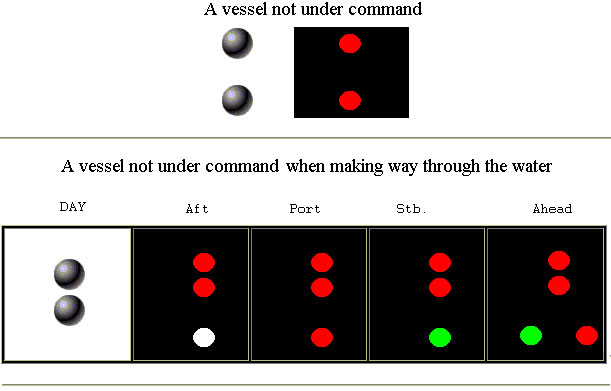 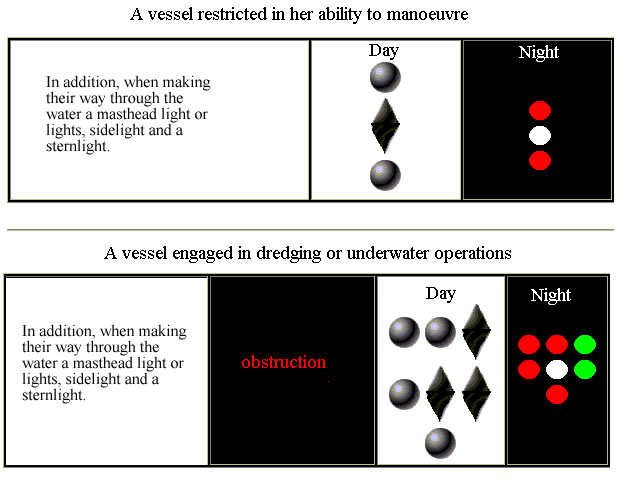 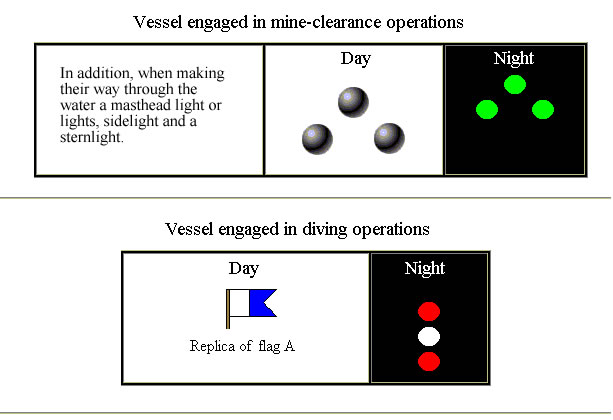 |
| Refer to pages 75-114, Chapter 7: Collision Regulations, Small Ships Training and Operational Manual, 4th Ed (2005) Maritime Safety Queensland See also John Mellor, A Small Boat Guide to Rules of the Road: The Collision Regulations Simplified, Wiley Press, 2006 |
Vessels Constrained by their Draught (Rule 28)
A vessel constrained by her draught may, in addition to the lights prescribed for power- driven vessels in Rule 23, exhibit where they can best be seen three all-round red lights in a vertical line, or a cylinder.
 |
| Refer to pages 75-114, Chapter 7: Collision Regulations, Small Ships Training and Operational Manual, 4th Ed (2005) Maritime Safety Queensland See also John Mellor, A Small Boat Guide to Rules of the Road: The Collision Regulations Simplified, Wiley Press, 2006 |
Pilot Vessels (Rule 29)
| (a) | A vessel engaged on pilotage duty shall exhibit: | |
| (i) at or near the masthead, two all-round lights in a vertical line, the upper being white and the lower red; (ii) when underway, in addition, sidelights and a sternlight; (iii) when at anchor, in addition to the lights prescribed in subparagraph (i), the light, lights or shape prescribed in Rule 30 for vessels at anchor. |
||
| (b) | A pilot vessel when not engaged on pilotage duty shall exhibit the lights or shapes prescribed for a similar vessel of her length. |
 |
| Refer to pages 75-114, Chapter 7: Collision Regulations, Small Ships Training and Operational Manual, 4th Ed (2005) Maritime Safety Queensland See also John Mellor, A Small Boat Guide to Rules of the Road: The Collision Regulations Simplified, Wiley Press, 2006 |
Anchored Vessels and Vessels Aground (Rule 30)
| (a) | A vessel at anchor shall exhibit where it can best be seen: | |
| (i) in the fore part, an all-round white light or one ball; (ii) at or near the stern and at a lower level than the light prescribed in subparagraph (i), an all-round white light. |
||
(b) |
A vessel of less than 50 metres in length may exhibit an all-round white light where it can best be seen instead of the lights prescribed in paragraph (a) of this Rule. | |
| (c) | A vessel at anchor may, and a vessel of 100 metres and more in length shall, also use the available working or equivalent lights to illuminate her decks. | |
| (d) | A vessel aground shall exhibit the lights prescribed in paragraph (a) or (b) of this Rule and in addition, where they can best be seen: | |
| (i) two all-round red lights in a vertical line; (ii) three balls in a vertical line. |
||
| (e) | A vessel of less than 7 metres in length, when at anchor, not in or near a narrow channel, fairway or anchorage, or where other vessels normally navigate, shall not be required to exhibit the lights or shape prescribed in paragraphs (a) and (b) of this Rule. | |
| (f) | A vessel of less than 12 metres in length, when aground, shall not be required to exhibit the lights or shapes prescribed in subparagraphs (d)(i) and (ii) of this Rule. |
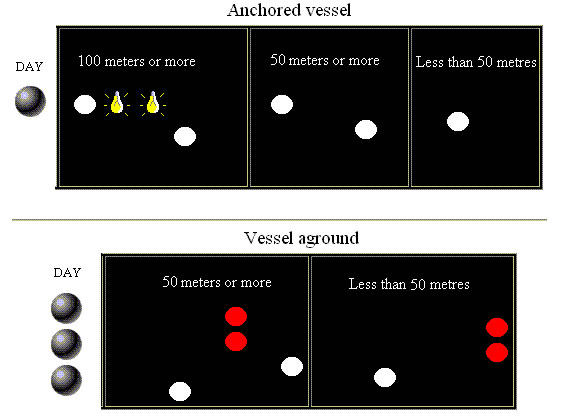 |
| Refer to pages 75-114, Chapter 7: Collision Regulations, Small Ships Training and Operational Manual, 4th Ed (2005) Maritime Safety Queensland See also John Mellor, A Small Boat Guide to Rules of the Road: The Collision Regulations Simplified, Wiley Press, 2006 |
| back to top |
